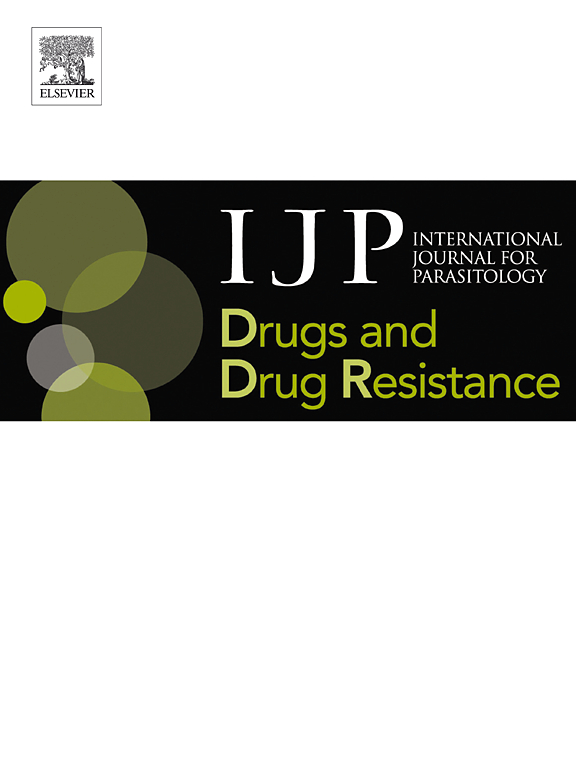Screening and hit evaluation of a microbial metabolite library against the pathogenic Plasmodium falciparum and Toxoplasma gondii parasites
IF 3.4
2区 医学
Q1 PARASITOLOGY
International Journal for Parasitology: Drugs and Drug Resistance
Pub Date : 2025-08-05
DOI:10.1016/j.ijpddr.2025.100606
引用次数: 0
Abstract
Frontline drug treatments for malaria are at risk of failing due to emerging resistance, meanwhile drugs used to treat toxoplasmosis have suboptimal efficacy and safety. As demonstrated by the success of clinically used antiparasitic drugs, the diverse structural complexity and biological activity of natural products holds great potential for drug discovery and development, to address the need for new compounds with novel mechanisms. Here we screened the BioAustralis Discovery Plates Series I library, a collection of 812 microbial natural product compounds including rare microbial metabolites, against Plasmodium falciparum erythrocytic stage and Toxoplasma gondii tachyzoite parasites. We identified 219 compounds that inhibited P. falciparum growth by at least 80 % at a concentration of 2 μg/mL (1–10 μM for >90 % of compounds), whilst 149 compounds demonstrated equivalent activity against T. gondii. The active compounds were assigned based on chemical structure to more than 50 compound classes. After triaging active compounds for those with low mammalian cytotoxicity, we defined the in vitro half maximal inhibitory concentration (IC50) of a selection of compounds against the parasites, identifying four compound groups with activity in the low nanomolar range. The macrocyclic lactone pladienolide B and cryptopleurine were found to be very potent against the parasites but also mammalian cells, warranting further structure-activity relationship investigation. Two groups, the monocyclic thiazole peptides, including micrococcin P1 and the thiocillins, and the pleuromutilins, exhibited both low antiparasitic IC50 and low cytotoxicity, highlighting their potential for further analysis. This study defines the activity of the BioAustralis Discovery Plates Series I against two apicomplexan parasites of significant global importance, providing potential new tools to study parasite biology and possible starting points for novel antiparasitic development.

致病性恶性疟原虫和刚地弓形虫寄生虫微生物代谢产物文库的筛选与命中评价
由于出现耐药性,疟疾的一线药物治疗面临失败的风险,同时用于治疗弓形虫病的药物的疗效和安全性也不理想。临床应用的抗寄生虫药物的成功表明,天然产物的多样性结构复杂性和生物活性为药物发现和开发提供了巨大的潜力,以满足对具有新机制的新化合物的需求。在这里,我们筛选了BioAustralis Discovery Plates Series I文库,该文库收集了812种微生物天然产物化合物,包括罕见的微生物代谢物,用于对抗恶性疟原虫红细胞期和弓形虫速殖子寄生虫。我们鉴定出219种化合物在浓度为2 μg/mL (1-10 μM占90%)时抑制恶性疟原虫生长至少80%,而149种化合物对弓形虫具有相同的抑制活性。根据化学结构将活性化合物划分为50多个化合物类。在对具有低哺乳动物细胞毒性的活性化合物进行分类后,我们确定了一组化合物对寄生虫的体外最大半数抑制浓度(IC50),确定了四组活性在低纳摩尔范围内的化合物。大环内酯pladienolide B和隐pleurine对寄生虫和哺乳动物细胞均有较强的抗虫活性,值得进一步的构效关系研究。两组单环噻唑肽,包括微球菌蛋白P1和硫西林,以及胸膜多肽,显示出低抗寄生虫IC50和低细胞毒性,突出了它们进一步分析的潜力。本研究确定了BioAustralis Discovery Plates Series I对两种具有重要全球意义的顶复合体寄生虫的活性,为研究寄生虫生物学提供了潜在的新工具,并为新型抗寄生虫开发提供了可能的起点。
本文章由计算机程序翻译,如有差异,请以英文原文为准。
求助全文
约1分钟内获得全文
求助全文
来源期刊

International Journal for Parasitology: Drugs and Drug Resistance
PARASITOLOGY-PHARMACOLOGY & PHARMACY
CiteScore
7.90
自引率
7.50%
发文量
31
审稿时长
48 days
期刊介绍:
The International Journal for Parasitology – Drugs and Drug Resistance is one of a series of specialist, open access journals launched by the International Journal for Parasitology. It publishes the results of original research in the area of anti-parasite drug identification, development and evaluation, and parasite drug resistance. The journal also covers research into natural products as anti-parasitic agents, and bioactive parasite products. Studies can be aimed at unicellular or multicellular parasites of human or veterinary importance.
 求助内容:
求助内容: 应助结果提醒方式:
应助结果提醒方式:


